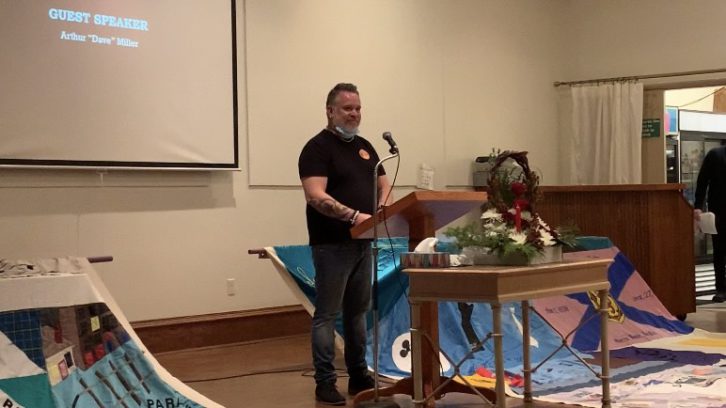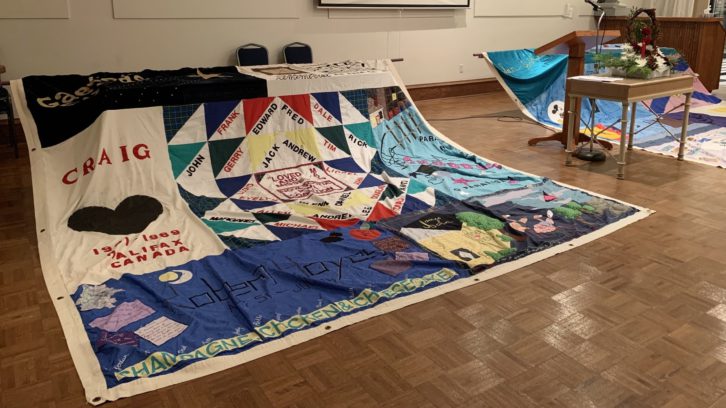Halifax AIDS vigil calls for support for Indigenous, Black communities
On World AIDS Day, speakers demand help for marginalized communities

caption
Chris Aucoin of AIDS Coalition of Nova Scotia, Elder Billy Lewis and Arthur (Dave) Miller light the vigil candles at the World AIDS vigil on Dec. 1, 2021.Dave Miller wants the same level of awareness and support during World AIDS Day, every day.
Miller is a Mi’kmaw HIV activist and works as a community health educator at Healing Our Nations, an organization based in Dartmouth working to educate Indigenous communities on AIDS and HIV.
“Indigenous HIV rates are a lot higher,” Miller said in an interview.
The AIDS Coalition of Nova Scotia, or ACNS, held a candlelight vigil on Dec. 1 for World AIDS Day, which also marks the start of Indigenous AIDS Awareness Week. Related stories
When asked how to support Indigenous communities, Miller said, “I think a good way is, you know, not to celebrate World AIDS Day or Indigenous AIDS Awareness Week, but you know have that awareness all year round.”

caption
Dave Miller speaks at the World AIDS Day vigil on Dec. 1, 2021.Mi’kmaw elder Billy Lewis spoke at the vigil, held at the Italian Cultural Centre on Agricola Street in Halifax. He said people should be encouraged to think about these issues every day.
“The phobias and prejudices that lead to discrimination are still alive and well,” Lewis said. “It can get very tokenistic in one day for this and another for that, and yet there’s no real consciousness that sticks.”
The Women Next Door, a lesbian-feminist choir based in Halifax, and the Halifax Gay Men’s Chorus performed songs virtually for the vigil.
Attendees lit vigil candles and volunteers read the names of those affected by HIV who have passed away, followed by a moment of silence.

caption
The Canadian AIDS Memorial Quilt was displayed on the podium at the World AIDS vigil on Dec. 1, 2021.The 2016 Canada Communicable Disease report for HIV surveillance showed that Indigenous and Black people made up less than five per cent of the population but represented more than 20 per cent of newly reported HIV cases.
In June 2018, the federal government released a five-year plan to reduce the health impact of sexually transmitted blood-borne infections like HIV.
Canada is now on the third year of this plan, but a joint letter sent in November by many AIDS activists to federal Health Minister Jean-Yves Duclos says that there’s still more work to be done.
“There’s always room for HIV education, and sort of where the mandate has changed over the years, there’s still the same amount of money that there’s always been,” Miller said.
“In certain communities they don’t have the same access to supports and services, and so there’s more money needed in terms of education, to bring out services to remote communities,” Miller said.
Dylan Samson is AIDS Coalition Nova Scotia’s program and support co-ordinator.
“Marginalization both impacts their risk factors for HIV, but also how they receive treatment, how they receive care,” Samson said.
To get on track with Canada’s five-year plan while supporting Indigenous, Black and other racialized groups, Samson said there needs to be a focus on increased funding and representation.
“Making sure to support organizations that are already leading people at the grassroots level,” Samson said. “Probably the most important part is making sure to continue to support those organizations, include the insight and input of those organizations.”
Samson added that there also needs to be increased access to testing.
“Increasing the accessibility of testing means that people who are diagnosed early can get on treatment early, and treatment itself is a form of prevention,” he said.
About the author

Avery Stewart
Avery Stewart is a journalist in Halifax. She has a background in English literature and philosophy.
